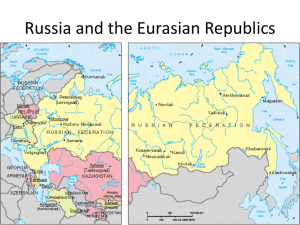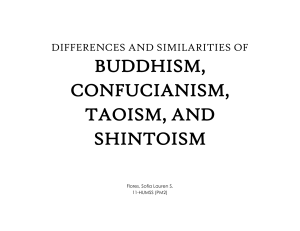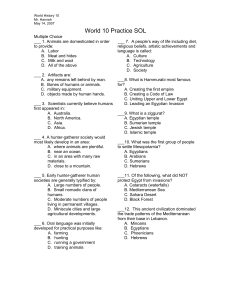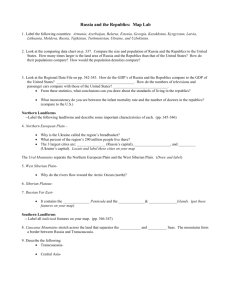Global Issues Study Guide
advertisement
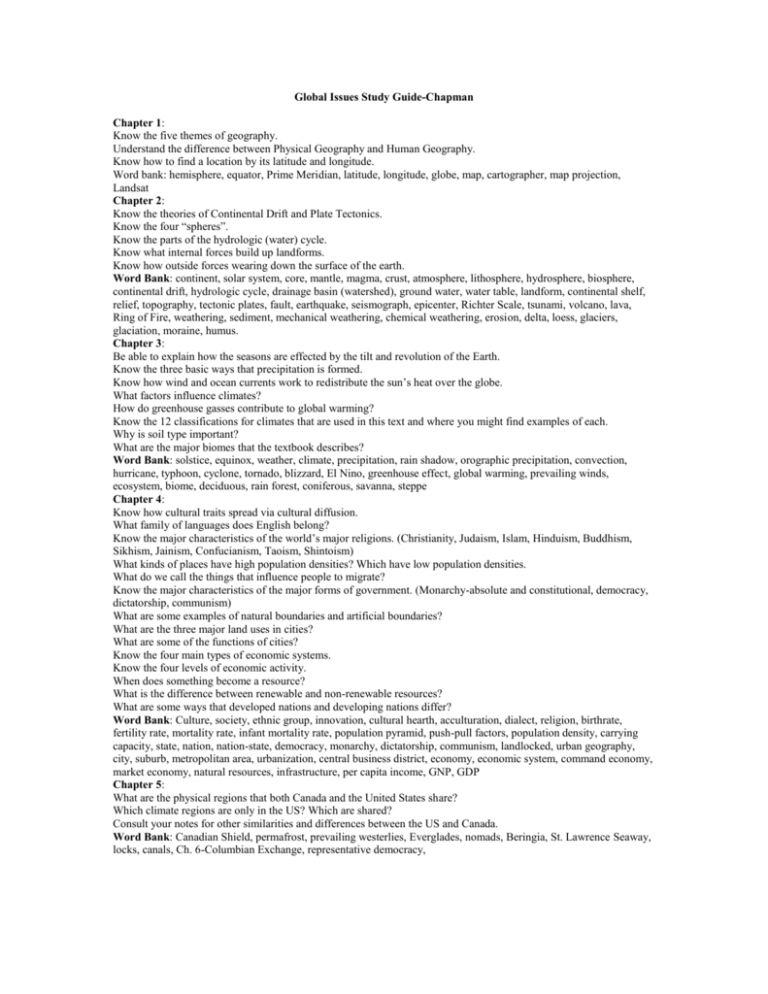
Global Issues Study Guide-Chapman Chapter 1: Know the five themes of geography. Understand the difference between Physical Geography and Human Geography. Know how to find a location by its latitude and longitude. Word bank: hemisphere, equator, Prime Meridian, latitude, longitude, globe, map, cartographer, map projection, Landsat Chapter 2: Know the theories of Continental Drift and Plate Tectonics. Know the four “spheres”. Know the parts of the hydrologic (water) cycle. Know what internal forces build up landforms. Know how outside forces wearing down the surface of the earth. Word Bank: continent, solar system, core, mantle, magma, crust, atmosphere, lithosphere, hydrosphere, biosphere, continental drift, hydrologic cycle, drainage basin (watershed), ground water, water table, landform, continental shelf, relief, topography, tectonic plates, fault, earthquake, seismograph, epicenter, Richter Scale, tsunami, volcano, lava, Ring of Fire, weathering, sediment, mechanical weathering, chemical weathering, erosion, delta, loess, glaciers, glaciation, moraine, humus. Chapter 3: Be able to explain how the seasons are effected by the tilt and revolution of the Earth. Know the three basic ways that precipitation is formed. Know how wind and ocean currents work to redistribute the sun’s heat over the globe. What factors influence climates? How do greenhouse gasses contribute to global warming? Know the 12 classifications for climates that are used in this text and where you might find examples of each. Why is soil type important? What are the major biomes that the textbook describes? Word Bank: solstice, equinox, weather, climate, precipitation, rain shadow, orographic precipitation, convection, hurricane, typhoon, cyclone, tornado, blizzard, El Nino, greenhouse effect, global warming, prevailing winds, ecosystem, biome, deciduous, rain forest, coniferous, savanna, steppe Chapter 4: Know how cultural traits spread via cultural diffusion. What family of languages does English belong? Know the major characteristics of the world’s major religions. (Christianity, Judaism, Islam, Hinduism, Buddhism, Sikhism, Jainism, Confucianism, Taoism, Shintoism) What kinds of places have high population densities? Which have low population densities. What do we call the things that influence people to migrate? Know the major characteristics of the major forms of government. (Monarchy-absolute and constitutional, democracy, dictatorship, communism) What are some examples of natural boundaries and artificial boundaries? What are the three major land uses in cities? What are some of the functions of cities? Know the four main types of economic systems. Know the four levels of economic activity. When does something become a resource? What is the difference between renewable and non-renewable resources? What are some ways that developed nations and developing nations differ? Word Bank: Culture, society, ethnic group, innovation, cultural hearth, acculturation, dialect, religion, birthrate, fertility rate, mortality rate, infant mortality rate, population pyramid, push-pull factors, population density, carrying capacity, state, nation, nation-state, democracy, monarchy, dictatorship, communism, landlocked, urban geography, city, suburb, metropolitan area, urbanization, central business district, economy, economic system, command economy, market economy, natural resources, infrastructure, per capita income, GNP, GDP Chapter 5: What are the physical regions that both Canada and the United States share? Which climate regions are only in the US? Which are shared? Consult your notes for other similarities and differences between the US and Canada. Word Bank: Canadian Shield, permafrost, prevailing westerlies, Everglades, nomads, Beringia, St. Lawrence Seaway, locks, canals, Ch. 6-Columbian Exchange, representative democracy, Chapters 9, 10 & 11: Know where the deserts of Mexico and South America are and their names. Who conquered whom? Pizarro and/or Cortes? Where do you find gauchos? Which Island in the Caribbean is shared by two countries, Haiti and the Dominican Republic? Word Bank: pampas, llanos, rain forest, slash-and-burn, terraced farming, push-and-pull factors, infrastructure, , mestizo, NAFTA, maquiladoras, cultural hearth, Panama, Canal, calypso, reggae, informal economy, biodiversity, deforestation, global warming, deb-for-nature swap Chapters 19 & 22 Africa and Southwest Africa Check your notes on the Keys to understanding Sub Saharan Africa and North Africa and the Middle East. How would you describe the terrain of Africa? What are the main deserts of Africa What does the term Colonial refer to when describing Africa? Why are Africa’s national boundaries so different (stupid) than those of almost all other regions? What activities contribute to desertification in the African Sahel? What disadvantage do landlocked countries have? What are the main beliefs, holy sites and rituals of the three main monotheistic religions? (By the way, do the same for the religions of South Asia--Hinduism, Buddhism, Sikhism, Jainism--and East Asia— Confucianism, Taoism and Shinto.) Word Bank: Berlin Conference, cash crop, pandemic, Olduvai Gorge, stateless society, Bantu migrations, apartheid, Mecca, mosque, theocracy, Sunni, Shi’ite, Hajj Chapters 25, 28 & 31: Asia, East by South and the Pacific World What Mountain Range separates South Asia from East Asia? What is the physics behind the monsoon winds? Which bring rains and which bring dry air? Why was India partitioned when it gained independence in 1947? What are some of the natural disasters that can at times plague Bangladesh? Which mountain range in China separates northern China and southern China? (Hint: the mountains are not that high.) What are some physical features of the Ring of Fire? Which countries in Asia are archipelagoes? What is the difference between the high islands and the low islands of the Pacific World? Where are Micronesia, Melanesia and Polynesia? Word Bank: monsoon, cyclone, Hinduism, caste system, partition, microcredit, Ramadan, constitutional monarchy, Sinhalese, Tamils, dynasty, Confucianism, Taoism, Buddhism, Mao Zedong, economic tiger, Pacific Rim, samurai, shogun, archipelago, high island, low island, Great Barrier Reef, atoll, Micronesia, Melanesia, Polynesia Chapters 12 & 13: Europe Know the time frame for the breakup of the Soviet Union. Know what NATO and The European Union are. What do we call a form of government where a monarch is controlled by an elected parliament? Word Bank: fjord, peat, North Atlantic Drift, sirocco, mistral, dike, polder, parliament, euro Unit 5: Russia and the Republics: Chapter 15: Where do most People live in Russia and the Republics that made up the Soviet Union? Which mountains separate European Russia from Siberia? What are the terms for the non-Russian Asian areas of this Region? Name the three largest lakes in this regions and an important fact about each. Which is the largest vegetation region of Russia? Word Bank: chernozem, Eurasia, continentality. Taiga, Trans-siberian Railroad Chapter 16. Refer to your “Russian Around Europe” notes. Does Russia have access to many warm-water ports? Which countries are in Central Asia? Word Bank: Baltic Republics, czar (tsar), Russian Revolution, USSR, Cold War, command economy, collective farm, Silk Road, Great Game, nomad, yurt
